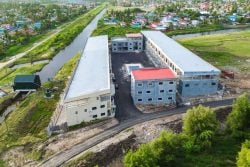Dear Editor,
Reference is made to the Alliance for Change’s (AFC) press statement issued on August 27, 2024, in respect of the Government of Guyana’s (GoG) proposed new bridge across the Berbice River.
In 2007, AFC Member of Parliament, Mr. David Patterson argued that the GoG should consider a fixed structure bridge instead of a floating structure. He argued then that a floating structure has a shorter lifespan and higher operating cost, while a fixed, concrete structure has a longer life-span and lower operating cost, that would offset the initial high capital cost (https://www.landofsixpeoples.com/news701/nc0701258.html).
Back then, Mr. Patterson’s argument was on point. But back then as well, the combined Political Opposition propagated their usual political agenda. They had argued then, against the Berbice bridge project, alleging that the feasibility study was “doctored”.
The indisputable fact is that a full-fledged feasibility study was done in 2007 by a prominent international firm. The feasibility study for the Berbice bridge at that time had considered both options (the fixed vs. the floating).
However, the government’s central limitation was the lack of financial resources, hence, the “Public Private Partnership (PPP)” funding model was explored to finance the bridge. This was the main reason why the GoG had to settle for the floating structure, as opposed to the fixed structure.
Now that the lifespan of the existing floating bridge will soon expire (2027), it is the sensible thing to do—that is, to construct a modern, fixed concrete structure bridge to replace the floating structure. As Mr. Patterson himself had correctly argued in 2007, the fixed structure carries a higher initial capital cost, but a longer lifespan and lower operating cost. Moreover, as the useful life of the bridge expires, the operating cost will be significantly higher thereafter. This means that it would not be feasible to continue maintaining a floating structure bridge after its useful life will have expired. The cost thereof may outweigh the cost of investing in a new bridge with a longer lifespan and lower operating cost. Its commonsensical.
Furthermore, in order for there to be serious development to take place at the desired pace and outcome, a fixed
structure bridge is necessary; one that would not disrupt the movement of goods and people due to the closure to vehicular traffic lasting 1.5-2 hours daily. This is an implicit cost to the users of the bridge, both commuters and businesses.
In due course, I will explore this argument in greater depth by way of a cost benefit analysis to answer two key questions: (i) to determine the net benefit derived from the existing bridge, whether the country has received its return on investment (ROI) over the useful life of the bridge, and (ii) the net benefit of the new proposed fixed structure, the stream of benefits that will flow therefrom, together with all the other developments taking place along that corridor.
Yours sincerely,
Joel Bhagwandin




